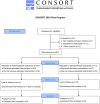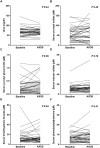The Influence of Prebiotic Arabinoxylan Oligosaccharides on Microbiota Derived Uremic Retention Solutes in Patients with Chronic Kidney Disease: A Randomized Controlled Trial
- PMID: 27100399
- PMCID: PMC4839737
- DOI: 10.1371/journal.pone.0153893
The Influence of Prebiotic Arabinoxylan Oligosaccharides on Microbiota Derived Uremic Retention Solutes in Patients with Chronic Kidney Disease: A Randomized Controlled Trial
Abstract
The colonic microbial metabolism is a key contributor to uremic retention solutes accumulating in patients with CKD, relating to adverse outcomes and insulin resistance. Whether prebiotics can reduce intestinal generation of these microbial metabolites and improve insulin resistance in CKD patients not yet on dialysis remains unknown. We performed a randomized, placebo-controlled, double-blind, cross-over study in 40 patients with eGFR between 15 and 45 ml/min/1.73 m2. Patients were randomized to sequential treatment with prebiotic arabinoxylan oligosaccharides (AXOS) (10 g twice daily) and maltodextrin for 4 weeks, or vice versa, with a 4-week wash-out period between both intervention periods. Serum levels and 24h urinary excretion of p-cresyl sulfate, p-cresyl glucuronide, indoxyl sulfate, trimethylamine N-oxide and phenylacetylglutamine were determined at each time point using liquid chromatography-tandem mass spectrometry. In addition, insulin resistance was estimated by the homeostatic model assessment (HOMA-IR). A total of 39 patients completed the study. We observed no significant effect of AXOS on serum p-cresyl sulfate (P 0.42), p-cresyl glucuronide (P 0.59), indoxyl sulfate (P 0.70) and phenylacetylglutamine (P 0.41) and a small, albeit significant decreasing effect on serum trimethylamine N-oxide (P 0.04). There were neither effect of AXOS on 24h urinary excretion of p-cresyl sulfate (P 0.31), p-cresyl glucuronide (P 0.23), indoxyl sulfate (P 0.87) and phenylacetylglutamine (P 0.43), nor on 24h urinary excretion of trimethylamine N-oxide (P 0.97). In addition, we observed no significant change in HOMA-IR (P 0.93). In conclusion, we could not demonstrate an influence of prebiotic AXOS on microbiota derived uremic retention solutes and insulin resistance in patients with CKD not yet on dialysis. Further study is necessary to elucidate whether prebiotic therapy with other characteristics, higher cumulative exposure or in different patient populations may be of benefit.
Trial registration: Clinicaltrials.gov NCT02141815.
Conflict of interest statement
Figures



References
-
- Meyer TW, Hostetter TH. Uremia. N Engl J Med 2007. September 27;357(13):1316–25. - PubMed
-
- Bammens B, Evenepoel P, Keuleers H, Verbeke K, Vanrenterghem Y. Free serum concentrations of the protein-bound retention solute p-cresol predict mortality in hemodialysis patients. Kidney Int 2006. March;69(6):1081–7. - PubMed
Publication types
MeSH terms
Substances
Associated data
LinkOut - more resources
Full Text Sources
Other Literature Sources
Medical
Research Materials
Miscellaneous

